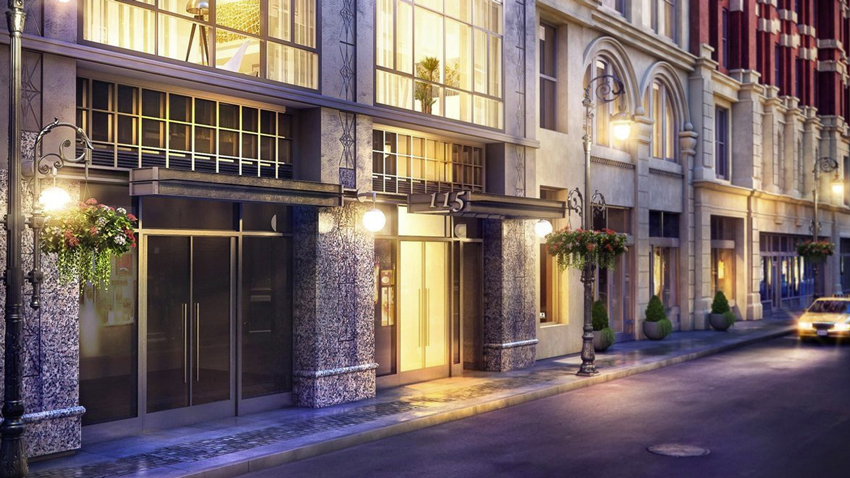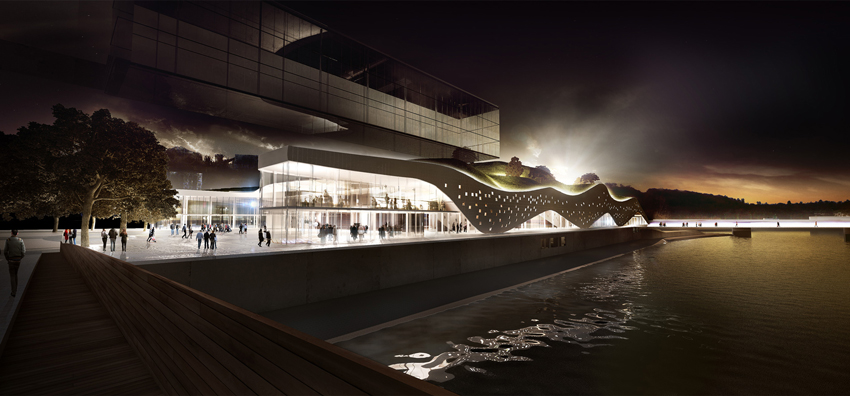Designing with Concrete in the 21st Century
Architectural and Decorative Concrete
The term “architectural concrete” refers to concrete that, while providing a structural function, also achieves an aesthetic finish to a building. By contrast, “decorative concrete” typically refers to concrete flatwork or building elements that are enhanced with texture or color but are not structural building components. In either case, the concrete can be mixed and treated to take almost any form, texture, or color. Forming is a matter of creating the appropriate forms or molds for the material to be set into.

© Agence Rudy Ricciotti
Concrete can be formulated by adjusting the type and proportion of ingredients to achieve a range of compressive and even tensile loading strengths.
Texture here refers to the finished surfaces, which can be very smooth, patterned, or intentionally rough. A sometimes popular decorative surface technique uses exposed aggregate, which is achieved by removing the outer layer of cement and exposing the inner aggregate particles. This might be performed using chemical surface retarders, sandblasting, water blasting, acid etching, or other techniques. Nonetheless, it becomes important to select the aggregates that will be exposed based on the characteristics needed to achieve good results— i.e., color, hardness, size, shape, durability, and cost. Some popular decorative aggregates include things like quartz, granite, marble, limestone, and gravel or manufactured materials such as alkali-resistant glass and ceramics.

Photo courtesy Gerner, Kronick + Valcarcel, Architects
Architectural concrete can be fashioned into a broad range of appearances and finishes in addition to providing structural support to a facade or overall building.
The colors of architectural or decorative concrete can vary based on the aggregates in the mix to create a wide range of integral hues. Color can also be affected by the cement used since each has different inherent color tones as a result of slight differences in raw material ingredients and manufacturing processes. Portland cement can retain its white color if it is made of select materials that contain negligible amounts of iron and manganese oxides, which can otherwise give cement a gray color. Architectural or decorative concrete can also be enhanced by adding mineral oxide pigments to add some specific coloring. When lighter shades of color are desired, white cement should be used, but reds, tans, and dark gray hues can be produced using gray cement.
Textures and patterns in the surface of architectural and decorative concrete are quite possible using forms and form liners. Artistic, free-form, or geometric patterns can be produced this way, or the surface can simulate other materials, such as brick, stone, and wood. Form liners are readily available made from aluminum with stock brick-pattern faces or with vertical rib or board-and-batten patterns. Custom variations are possible, too. The benefits of taking this approach include an enhanced visual appearance to a wall or facade, and the ability to camouflage any subtle differences in texture and color found on the surface of the concrete. Overall, the result allows for the creation of a well-designed surface that is complete unto itself whether it provides structural support or not.
Light-Transmitting Concrete
Concrete has the properties of being quite solid, heavy, and dense so it’s not surprising that it is thought of in those terms. However, some recent developments have given designers a chance to think quite differently about concrete as a material that can bring light into a space in creative and surprising ways. Some researchers and companies have begun embedding optical fibers that run from one side of a section of concrete to the other, quite effectively transmitting light from one side to the other. Depending on the materials and conditions of this experimental approach, colors and light have been found to remain remarkably consistent throughout the concrete. In some cases, the optical fibers have been able to carry light over 50 feet without significantly impacting the other properties of the concrete since they occupy only a small percentage of the total concrete block or panel.
Architects and others have begun to imagine many artistic and functional applications for this innovative concrete development. Daylighting is a real possibility with the ability to carry and direct light exactly where needed for uniform, glare-free installations. Optical fibers are known to transmit light so effectively that there is virtually no loss of light conducted through the fibers so the effectiveness of this approach has great potential. It is also possible to transmit natural or artificial light to areas that need it because of a lack of other light. For example, experimentation is being done to light indoor fire escapes in case of a power failure or to illuminate sidewalks at night.
Fabricating light-transmitting concrete has been done in a variety of ways. In some cases, fiber filaments were placed individually in the concrete, which was, not surprisingly, quite time consuming and costly. Semi-automatic production processes have also been tried using woven fiber fabric instead of single filaments. In this case, the fabric and concrete are alternately inserted into molds at predetermined intervals. In order to protect the fibers from damage, the concrete mixture is made from fine materials only, without any coarse aggregate. Once the concrete is added into a form with the pre-placed fibers, it can be cut into panels or blocks for use in buildings. The surface can be left unfinished or be polished, resulting in a semi-gloss or even a high-gloss finish.

© Agence Rudy Ricciotti
Concrete in the 21st century can be formulated and formed to provide characteristics not previously available, such as the ability to be self-cleaning or the ability to transmit light through optical fibers.
Self-cleaning Concrete
One of the problems of any exterior building surface, particularly high-rise buildings, is how to keep the exterior clean over time. Any porous stone, masonry, or concrete often suffers from a collection of dirt, dust, and pollution over time that darkens the color of the building and reveals the fact that it is indeed quite dirty. Beyond the aesthetic disappointment of such a condition, the pollutants and dirt, particularly when wet, could react with and begin to degrade the building materials. In order to address this problem, some recently introduced formulations of cement have been found to be capable of neutralizing pollution, turning otherwise harmful smog into compounds that are quite harmless and can be washed away. Since these cement formulations are comparable to using portland cements, they are ideal for exposed concrete buildings.
The technology that makes this possible is based on adding particles of titanium dioxide to white or gray cement, during its manufacture. Doing so does not change the fundamental character of the cement allowing it to work like any other portland cement for use in all varieties of concrete. The added chemical simply works together with sunlight to break down smog or other pollution that have become attached to the concrete. The process is known as photocatalysis and relies on sunlight hitting the surface of the concrete to neutralize most organic and some inorganic pollutants, thus avoiding discoloration. Of particular interest to building owners, the titanium dioxide acts simply as a catalyst that does not disappear as it breaks down pollution, and continues to keep working over time. Typically, this photocatalytic concrete creates a reaction with common hydrocarbon pollutants and produces less harmful chemical byproducts, such as oxygen, water, and small amounts of carbon dioxide. Wind or rainwater can then readily wash these materials away from the concrete surface, allowing buildings to stay cleaner without the need for added chemical or mechanical cleaning. This has been shown to be true even in highly polluted locations, such as the white concrete Air France headquarters building at Roissy-Charles de Gaulle International Airport near Paris, which remains white due to the self-cleaning concrete used.
An additional potential benefit to using a titanium dioxide formulation in concrete is the ability to help cleanse the air. Fossil fuel combustion in cars and buildings emits invisible air pollution including carbon dioxide (CO2), nitrogen oxide (NOx), and sulfur oxide (SOx) that can lead to acid rain, smog, global warming, and respiratory issues. Photocatalytic concrete exposed to sunlight has been shown to foster the natural breakdown of harmful NOx into harmless nitrates. Without the catalyst, the NOx breaks down in the atmosphere that we all breathe. How well might this work? A study conducted in the Netherlands used photocatalytic concrete pavers on a section of a busy roadway and monitored the air quality between 19.5 to 58.5 inches above the pavement. This was done in both a control area with normal pavers and the test section with photocatalytic pavers. The results found that the NOx levels were reduced by 25 to 45 percent by using the photocatalytic concrete.









